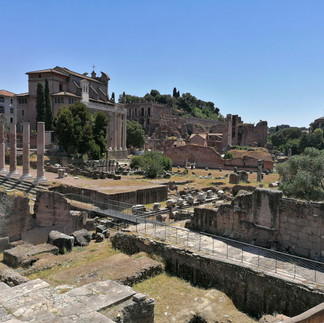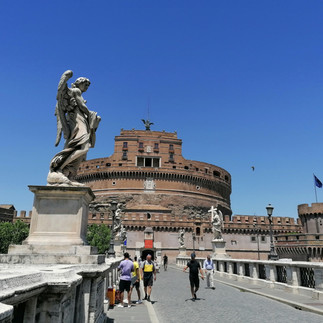Rome
What to see in Rome on a weekend: suggestions from those who have lived there!

Roma Caput Mundi it is one of the most beautiful cities in Europe
It would take months to visit all of it, but luckily the main monuments are all in the central area and can be easily reached on foot.
History of the city and legendary origins
According to legend, Ascanio, son of the Trajan hero Aeneas, founded the city of Alba Longa on the right bank of the Tiber. Many of his descendants reigned here, up to the brothers Numitor and Amulius; the latter seized the throne and forced his brother's only daughter to take a vow of chastity but the god Mars fell in love with her and after possessing her made her the mother of twins: Romulus and Remus. Amulius ordered his soldiers to kill them, but out of pity they spared them and abandoned them in a basket along the Tiber.
A she-wolf found them and nursed them in her lair on Mount Palatine until they were found by a shepherd who adopted them and raised them together with his wife. Adults, Romulus and Remus killed the king and founded a city in the place where they had been suckled by the she-wolf. It is hypothesized that the "wolf" was their real adoptive mother, being a term used to contemptuously indicate prostitutes. During the foundation of the city Romulus killed Remus and thus became the first and only King of Rome in 754 BC.
According to ancient interpretations, the origin of the city's name comes from the archaic name of the Tiber, "Rumon" or "Rumen", and Rome would mean the "City on the River".
Over the centuries Rome became the seat of the grandiose Roman Empire, where Caesar, Octavian Augustus first Emperor of Rome followed one another, Constantine who in 313 granted freedom of worship to Christians and Theodosius who in 381 recognized Christianity as an official religion and whose death occurred the division between the Eastern Roman Empire with the capital Constantinople and the Western Roman Empire with the capital Rome. After about a century, nomadic populations entered Italy and the Western Empire declined, marking the beginning of the Middle Ages. The city was depopulated but remained of strategic importance due to the presence of the pope and when in 800 AD. Charlemagne went down to Rome to be crowned emperor by Pope Leo III; the Holy Roman Empire was born. With the papacy moving to Avignon, Rome underwent a long period of crisis. The awakening took place at the end of the 1400s when artists such as Raphael, Michelangelo, and Bramante were called to give it a new magnificence. In the seventeenth century, thanks to the new Baroque style and its exponents Bernini and Borromini, Rome was enriched with squares, fountains and churches. During the Risorgimento anti-clerical sentiments grew and in 1870 with the breach of Porta Pia the French who protected the papacy were expelled and the city was annexed to the Kingdom of Italy. In 1922 Benito Mussolini made the March on Rome and was commissioned by King Vittorio Emanuele III to create a new government, starting the fascist dictatorship which had its headquarters in Palazzo Venezia in the homonymous square. In 1929 the Lateran Pacts were signed to regulate relations between the State and the Vatican City.
After World War II Italy became a Republic and Rome became the seat of the Italian Parliament.
Main monuments
Walk from the Colosseum to Vatican City
Here is the list of monuments not to be missed. By following the itinerary on the map, you can visit them without getting too tired:
Colosseum, Foro Romano and Via dei Fori Imperiali, Colle Palatino e Circo Massimo. From here, after a quarter of an hour's walk, you can reach the Giardino degli Aranci, where there is the particular door of the Order of Malta, from whose lock you can admire the dome of St. Peter's.
Piazza del Campidoglio and the beatuful church of Ara Coeli
Piazza Venezia and Altare della Patria where is the tomb of the unknown soldier.
Skirting the Teatro Marcello, you arrive at the Jewish Ghetto with the Synagogue of the Tempio Maggiore. From here you can continue towards the Tiber to reach the Tiber Island and then Trastevere, or go towards Campo dei Fiori.
Piazza Navona and the fountain of Neptune.
Pantheon and Piazza di Montecitorio
Trevi fountain
Piazza di Spagna with Scalinata di Trinità dei Monti, Via Condotti of luxury boutiques, via Margutta (the Street of Art) and Tiramisu di Pompi (in via della Croce)
Via del Corso up to Piazza del Popolo with the Egyptian obelisk and the stairway towards the Pincio promenade with a magnificent view and the Villa Borghese Park with its very tall maritime pines.
Ara Pacis monument, beautiful even during the night to be admired from the outside.
Castel Sant'Angelo and the most evocative bridge in the city built by Emperor Hadrian and adorned by Bernini with statues of Angels.
Vatican City with St. Peter's Basilica (with the climb to the dome) and the Vatican Museums, beautiful where there are magnificent works and the Sistine Chapel (the visit takes several hours and it is better to buy tickets in advance)
Santa Maria degli Angeli e dei Martiri at the Repubblica metro station with the stupendous glass dome.
Basilica of Trastevere with its golden mosaics and of course the district of the same name with the most romantic alleys of the city.
Particular neighborhoods and unusual places
Unusual Rome
In Rome, each neighborhood has its own beauty and uniqueness. Among the less touristy and more particular neighborhoods there are:
Park of Villa Torlonia, where in the spring it fills up with kids on the weekends who play and play on the lawns, the Casa delle Civette and a visit to the Catacombs.
Piazza Bologna, the center of university life with the best bars for aperitifs.
The Pyramid of Porta Ostiense and nearby Testaccio with various nightlife venues
Appia Antica Park.
Porta Portuense market where on Saturday morning in Via Portuense there is the largest market among stalls, vintage and stolen objects.
San Lorenzo, the district underground.
Via del Pigneto, is full of cafes, bookshops and alternative markets.
Coppedè district, the liberty district with the Villino delle Fate and Piazza Mincio.
Galleria Prospettica del Borromini nel cortile di Palazzo Spada.
The Scala Santa of Pontius Pilate near the Basilica of San Giovanni in Laterano.
Murales of Tor Pignattara (https://ilovetorpignart.wordpress.com)
Unique and unforgettable experiences
Magical nights in Rome
Around Rome you can spend a day at:
Spend an evening in Trastevere, trivial but obligatory.
Panoramic view of Rome at sunset from the Belvedere del Gianicolo or in small from the Ara Coeli.
Eat Tiramisù da Pompi (classic or pistachio).
Go to the Magic Door in Piazza Vittorio Emanuele II and try to decipher the ancient verses to make it reopen.
See the Capuchin Crypt in Via Veneto decorated with the bones of over 4,000 friars.
Promenade del Gelsomino, above the former track of the Vatican Railway with an unusual view of the dome of St. Peter's; it can be reached from a side street off via di Porta Cavalleggeri.
Being insulted and laughing heartily at the Parolaccia restaurant (menu and fixed price).
See a tennis match at the Foro Italico or take part in the May 1st Concert.
Go to a music show or the Rome Film Festival inside the Auditorium Parco della Musica.
Out of town
Sea, lakes, castles and good food
Around Rome you can spend a day at:
Ostia Antica and Ostia Lido to take a dip in the sea (take the train directly from the city center to Roma Ostiense station).
Castel Gandolfo on the lake of the same name, with the papal summer seat and the nearby Castelli Romani where you can eat porchetta from Ariccia.
Villa d'Este and Villa Adriana in Tivoli.
Lake Martignano, an oasis of peace in nature, or the larger and more touristic Lake Bolsena.
Useful tips:
Transportation
In Rome you can get around on foot or by metro (always have some change with you). There are buses but they are not famous for their punctuality. You can also rent cars with the Enjoy car-sharing service.
Roma Pass
Of 48h or 72h to see the monuments and have access to:
Where to sleep
Always check the photos and the terms and conditions of the hotels and b&b carefully, you could have nasty surprises.
Eat and drink
In Rome you eat well, just avoid too touristy restaurants with cheap menus. Obviously to try the carbonara, the gricia, cacio e pepe, saltimbocca alla romana. Among the various places:
Momart in Piazza Bologna for the most incredible aperitifs in the capital.
"Dolce" bistro and pastry shop.
Tavern 51 and the Duke in Trastevere.
Osteria da Fortunata in Campo dei Fiori.
Gelateria Fassi since 1880 in via Principe Eugenio and Gelateria La Romana (the Algida was founded in Rome in 1946).
The Antica Birreria Peroni (the plant was opened in Rome in 1864).
Nightlife
Everywhere there are clubs, but the most vibrant areas are Trastevere, Campo dei Fiori. The LattePiù inspired by A Clockwork Orange and Ice Cube is particular.
Shopping and local markets
Via del Corso for shopping, Via dei Condotti for high fashion, Porta Portuense Market for atmosphere.
MUST PLACES:
Via dei Fori Imperiali all'imbrunire, Trastevere at evening, Passeggiata del Pincio, walking on Ponte Sant'Angelo.
Itinerary:












































Comments